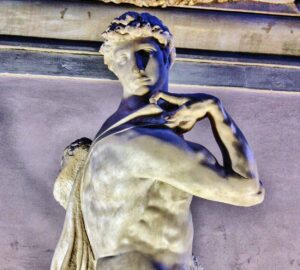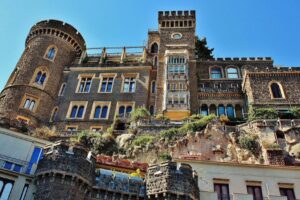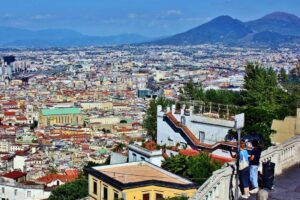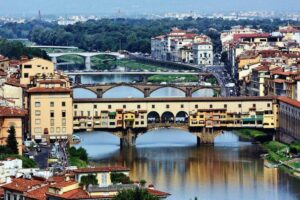One of the essential visits in Florence is undoubtedly the Palazzo Vecchio, the large building that has historically housed the civil power from the capital of Toscana.
I tell you that you visit of the Palazzo Vecchio It will bring you great surprises, but, above all, you will see reflected the great boom that the city of Florence has had throughout history.
The great tower that rises on the roof of the Palazzo Vecchio becomes the great distinctive architectural element of this building, which was the headquarters of the government of the Republic of Florence, and which currently houses the town hall of the capital of the Toscana.
All the information in detail
- 1 Curiosities from the history of the Palazzo Vecchio in Florence
- 1.1 Roman theater, origin of the Palazzo Vecchio in Florence
- 1.2 Palazzo Vecchio, former Courthouse in Florence
- 1.3 Arnolfo Tower in Palazzo Vecchio in Florence
- 1.4 Palazzo Vecchio, seat of the Government of Florence
- 1.5 Why is it called Palazzo Vecchio?
- 1.6 Palazzo Vecchio, seat of the kingdom of Italy
- 1.7 Sumptuous decoration of the Palazzo Vecchio
- 2 What to see when visiting the Palazzo Vecchio in Florence
- 3 Monumental Rooms of the Palazzo Vecchio
- 4 How to visit the Palazzo Vecchio in Florence
- 5 Visiting hours of the Palazzo Vecchio in Florence
- 6 Ticket prices for Palazzo Vecchio in Florence
- 7 Guided tours of Palazzo Vecchio in Florence
- 8 Secret Itineraries of the Palazzo Vecchio in Florence
Curiosities from the history of the Palazzo Vecchio in Florence
Roman theater, origin of the Palazzo Vecchio in Florence
The origins of Palazzo Vecchio They date back to the beginning of the 14th century, when it was decided to build the building on the site once occupied by the roman theater in florence.
In fact, after the excavations carried out in recent years, it is now possible to see, through previously arranged guided tours, the basements of the palace where remains of said theater are displayed.
Palazzo Vecchio, former Courthouse in Florence
Initially the building of the current Palazzo Vecchio had the function of courthouse, the same as that of the building that was previously in the same place, and in fact it came to be called for a time Palazzo dei Priori.
Arnolfo Tower in Palazzo Vecchio in Florence
Notice that the great tower of the Palazzo Vecchio, 94 meters high, which was built in 1310, is not located in the center of the building, since the foundations of the tower that was in the previous judicial building were used to support it.
This curiosity is especially appreciated when you find yourself in the Signoria square in front of the facade of the great palace.
Palazzo Vecchio, seat of the Government of Florence
It was in 1302 when the building became the headquarters of the lordshipthat is, the civil power of Florence, and began to be known as the Palazzo de la Signoria.
And today it also continues to be so because, as we have mentioned, this palace is now the headquarters of the town hall of the Tuscan capital.
Why is it called Palazzo Vecchio?
The name of Palazzo Vecchio It is because, starting in 1565, the Duke Cosimo I de Medici moved his residence to Pitti Palace, on the other shore of the Arno river.
For this reason, the large building in the center of Florence began to be known as the Old Palace.
Palazzo Vecchio, seat of the kingdom of Italy
Between 1865 and 1871 the Palazzo Vecchio acquired greater importance, as it became the seat of the Government Of reino from Italy, whose capital at that time was Florence.
Sumptuous decoration of the Palazzo Vecchio
When right now visit the Palazzo Vecchio, you will be touring a building that underwent various renovations, the most important in the 15th and 16th centuries.
The spectacular decoration of its impressive rooms, among which stands out the Cinquecento Hall, and the numerous works of art that you can see, are the greatest exponent of the great boom that this seat of civil power in Florence has had in history.
What to see when visiting the Palazzo Vecchio in Florence
Facing your visit of the Palazzo Vecchio, below we will tell you which are the main corners that you are going to see during it.
Michelozzo Courtyard
Your first stage of the visit should be Michelozzo Courtyard, the first of the courtyards you pass through as you enter the palace building from the Signoria square.
Designed in 1453 by MichelozzoIt is a simple patio, but due to the richness of its decoration, tourists usually gather around it to appreciate its great artistic beauty.
Square in shape, on your walk through the Michelozzo Courtyard in the Palazzo Vecchio in Florence You will see the large columns that support the gallery that surrounds the patio, which present a great stucco decoration.
On the ceilings and walls of the gallery you should pay attention to the spectacular frescoes that decorate them, which were painted by Giorgio Vasari in 1565 for the wedding celebrations of Francis I de Medici.
The assembly Michelozzo courtyard is completed with a pretty source located in the center of it, which was installed in 1557 to replace an old well.
ORGANIZE your TRIP
- Don't forget your TRAVEL INSURANCE with a 5% discount
- Book the HOTEL for your trip
- RENT a CAR for your trip
- The best TOURS and EXCURSIONS in Spanish
- NO-LINE TICKETS for museums and monuments
- Best FREE TOURS around the world
- Book your TRANSFER from the airport
- eSIM card with INTERNET at the best price
At the top of the fountain there is a small sculpture, known as the Angel with the Dolphin, which was made by Verrochio.
As a curiosity, I tell you that the sculpture that you can now see is a copy that in 1959 replaced the original, which is located on the second floor of the Palazzo Vecchio.
Great Hall of the Cinquecento
Undoubtedly, the Great Hall of the Cinquecento It is the room that best reflects the greatness of the Palazzo Vecchio and the Republic of Florence.
You should walk through this enormous room carefully given the large number of artworks that concentrates inside.
El Cinquecento Hall of the Palazzo Vecchio It began to be built in 1494 by order of Simone del Pollaiolo, after the restoration of the Republic of Florence once expelled Peter de Medici.
Subsequently the Great Hall of the Palazzo Vecchio was expanded by Giorgio Vasari.
With a length of 52 meters and a width of 23 meters, the Cinquecento Hall It configures a huge room of 1.200 square meters.
The purpose of the room was to be the meeting place of the Great advice, the institution that brought together all people with citizen rights in the Republic of Florence, which was made up of 500 members.
During the initial construction of the Cinquecento Hall two enormous frescoes were commissioned from Miguel Angel and Leonardo Da Vinci, in which scenes of two great victories of the Florentine republic were going to be captured.
But these works were not finished, leaving only some of the original sketches of Miguel Angel.
The decoration that you can now in the Cinquecento Hall, mannerist style, was made by Giorgio Vasari in the middle of the 16th century.
When you get to Cinquecento Hall, on your journey through the Palazzo Vecchio, initially you have to look at the huge roof 18 meters high, whose 1.200 square meters do not rest on any column.
In its 39 panels scenes from the life of Cosimo I, painted by Vasari.
On the large walls of the living room you will see enormous painted frescoes by himself Vasari with scenes of the different victories of the Republic of Florence against Pisa y Siena.
And on the sides of the room you can also see various sculptural groups, among which the Genius of Victory de Miguel Angel.
All the best views of the Cinquecento Hall You will have it when, after climbing the beautiful Vasari Staircase, you reach the second floor and can look out onto the balcony located at the back of said large room.
From there you will have a different view and you will be able to appreciate the immensity of this large room.

Michael's Genius of Victory Angel in Palazzo Vecchio
This monumental sculpture was sculpted in marble by Miguel Angel between 1532 and 1534, within a great project that occupied several years of his life, the Tomb of Pope Julius II.
You must see this monumental tomb in the church of San Pietro and Vincoli, riding a Roma, since another of the great masterpieces of Miguel Angel, Moses.
Don't forget your Travel Insurance
Are you organizing your trip or getaway? Don't leave without take out your travel insurance before, and here we explain why. If you hire it with us, you have a 5% discount
As to Genius of Victory, 2,65 meters high, shows two figures fighting, one of which appears as the winner.
The sculpture would be integrated into the aforementioned papal tomb that is in Rome, but finally Miguel Angel had to develop another project of the same and the Genius of Victory It remained in the artist's studio until his death.
After said death, the sculpture was acquired to be installed in the Palazzo Vecchio, where you can now see it on the south side of the main (and huge...) room of said palace, the aforementioned Cinquecento Hall.
Monumental Rooms of the Palazzo Vecchio
Most of your visit of the Palazzo Vecchio will concentrate on the walk through the so-called Monumental RoomsSeveral lounges and rooms where you will be surprised by its majestic decoration.
Room of Pope Leo X in Palazzo Vecchio
Among them is the Pope Leo X Room, dedicated to whoever was the son of Lorenzo the Magnificent, one of the most prominent members of the dynasty of the doctors (15th century).
Currently, this room is used as a representation room for the Florence Town Hall.
On the roof of the Leon X Room You can see large rectangular panels with allegorical paintings of his life, while the walls are occupied by large paintings.
Hall of Clement VII in Palazzo Vecchio
Another of the outstanding rooms of the Monumental Rooms is Hall of Clement VII, another pope of the dynasty doctors, also decorated with large paintings.
But in addition to this group of rooms on the first floor, in your visit of the Palazzo Vecchio You can also visit other lavishly decorated rooms on the second floor.
Vasari Staircase in Palazzo Vecchio
To get to them you must climb through another of the most spectacular corners of this great palace, the monumental Vasari Staircase, where you should look at the lavish paintings on the ceiling.
In this second floor of the Palazzo Vecchio, the most spectacularly decorated rooms are, possibly, the Hall of Lilies and the Audience.
Halls of the Lilies and the Audience
El Hall of Lilies It has this name for fleur-de-lys French, which is represented continuously in its coffered ceiling.
You can also see some frescoes of Domenico Ghirlandaio that spectacularly decorate one of its walls, as well as one of the masterpieces of Donatello, Judith and Holofernes.
And in the Courtroom, in addition to the great decoration of the walls, you will be able to see its vaulted ceiling covered in pure gold.
In short, the Palazzo Vecchio must be a essential visit in your travel plan to Florence, and during it you will enjoy corners of incredible beauty, a reflection of the boom that this Tuscan city had in the past.
Book your hotel, 15% discount, free cancellation
When planning your trip, we advise you to, well in advance, Book your hotel now on booking.com where you can find discounts from 15% and you will have a possible cancellation for free
How to visit the Palazzo Vecchio in Florence
For plan your visit to Palazzo Vecchio, then I give you some tips which will surely be useful to you.
Visiting hours of the Palazzo Vecchio in Florence
Contrary to what is usually common in museums and monuments in Europe, in the Palazzo Vecchio you find a extensive visiting hours.
In particular, the Palazzo Vecchio visiting hours They are throughout the year, from Monday to Sunday, from 9 a.m. to 19 p.m., except on Thursdays, when the visit ends at 14 p.m.
Last access is one hour before closing time.
Ticket prices for Palazzo Vecchio in Florence
The ticket prices to visit the Palazzo Vecchio They are 12,50 euros for adults, with a reduced entrance fee of 10 euros for young people from 18 to 25 years old and university students.
Admission is free for children and young people up to 18 years old.
Guided tours of Palazzo Vecchio in Florence
Without a doubt, the best way to visit the Palazzo Vecchio de Florence is to sign up for one tour, which will allow you to deepen your knowledge of this lavish monument in Tuscany.
Here you have an option with a duration of two hours or with a tourist guide in Spanish, in which you will avoid waiting in line for the entrance and will tour the main halls of the palace.
Here you have more details about these guided tours of the Palazzo Vecchio in Spanish, for which Mondays are a very ideal day since the rest of the museums in Florence are closed.
Secret Itineraries of the Palazzo Vecchio in Florence
You also have the option to sign up for Secret Itineraries Tour, which with a duration of an hour and a quarter, you can do en español and takes you to small and sumptuous rooms of the Palazzo Vecchio, such as the Hall of Maps, which can only be seen this way.
Reserve your RENTAL CAR now for your trip
Looking ahead to your trip, book your rental car now on this website that offers you the best price guaranteed and allows you a possible free cancellation in most cases. Here you have more information with tips for renting a car
Furthermore, in this guided tour you have an interesting introduction that allows you to know the history of the Republic of Florence and the Palazzo Vecchio itself.

















My hope is that I will visit the Palazzo Vecchio on the next day 14, and you will know how to prenote the free guided tour in Spanish, if on the morning in the morning.
Thanks so much.
My hope is that I will visit the Palazzo Vecchio on the next day 14, and you will know how to prenote the free guided tour in Spanish, if on the morning in the morning.
Thanks so much.